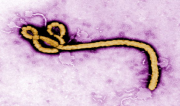A Closer Look at Ebola and the Immune System
As national and international health agencies and other groups shift their focus during the current outbreak of the Ebola virus from treatment of those patients with the virus to preventing further large scale events, a team of researchers has reported some success in looking at how Ebola compromises an infected person's immune system.

As national and international health agencies and other groups shift their focus during the current outbreak of the Ebola virus from treatment of those patients with the virus to preventing further large scale events, a team of researchers has reported some success in looking at how Ebola compromises an infected person’s immune system.
A statement from the Argonne National Laboratory said researchers from the Washington University School of Medicine “have identified one way the Ebola virus dodges the body’s antiviral defenses, providing important insight that could lead to new therapies.”
The team published its findings in a recent edition of Cell Host & Microbe. In the article, the authors looked at how VP24, a non-pathogenic Ebola protein, “binds to a host protein that takes signaling molecules in and out of the cell nucleus,” the statement noted.
The study authors noted that one of the main trademarks of viruses like Ebola and Marburg “is the rapid and potent suppression of innate antiviral immune responses,” which they said raises the fatality levels to close to 90% for some strains of Ebola.
“The data reveal direct competition between eVP24 and PY-Stat1 for the NPI-1 subfamily of nuclear transporters, which promotes inhibition of cell-intrinsic innate immune response and renders
Ebola virus infected cells insensitive to IFN treatment,” they added of their study.
Future treatment of the Ebola virus as a result of their work can be accomplished in many ways, the authors said.
“In addition to providing a mechanism for direct inhibition of cell-intrinsic immunity, our model allows us to rationalize how EBOV-infected cells may continue to function normally during initial stages of infection, as the nucleocytoplasmic trafficking of CNLS-containing cargo remain unaffected while JAK/STAT signaling is shut off.”